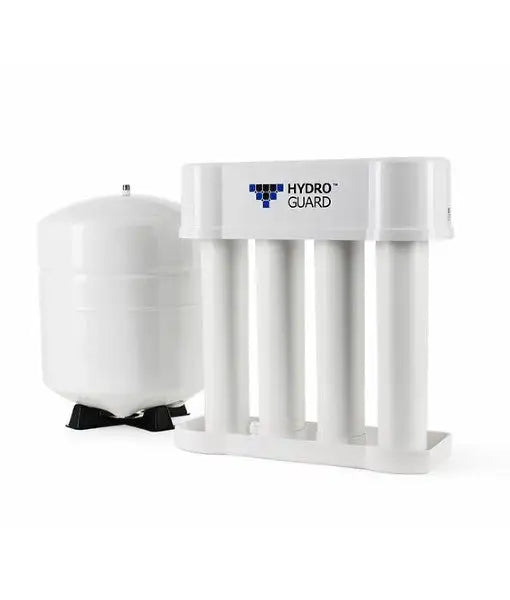Reverse Osmosis Water Filtration: Everything You Need to Know

Reverse osmosis technology improves the appearance, taste,and odor of drinking water. A reverse osmosis water filtration system uses a semipermeable membrane to remove ions, molecules, and particles from water resulting in healthy, safe water. Other benefits of an RO system include providing clean, refreshing water that's far more economical than bottled water or cheap temporary solutions like a pitcher or faucet filter. In the following article, learn all about reverse osmosis water filtration including the history behind the technology, how reverse osmosis works, and the benefits of a reverse osmosis water filtration system.
Table of Contents
- A Brief History of Reverse Osmosis Water
- What Is RO Water?
- Osmosis: A Life Function
- Semi-Permeable Membrane for Reverse Osmosis
- Comparing Osmosis and Reverse Osmosis
- How Does Reverse Osmosis Work?
- What Happens to the Contaminants during Reverse Osmosis?
- Basic Components of an RO System
- Permeate Pump
- What Contaminants Are Removed By a Reverse Osmosis Water Filtration System?
- Pre-treatment
- Fouling of RO Membrane
- Multimedia Water Filters
- Microfiltration
- Scaling in Reverse Osmosis Systems
- Antiscalants and Scale Inhibitors
- Chemical Effects on TFC Membranes
- Sodium Bisulfite Injection and Granular Activated Carbon
- Mechanical Damage on RO Systems
- Finals Thoughts
A Brief History of Reverse Osmosis and Water Filtration Technology
Seabirds have a special membrane that allows them to drink seawater. The membrane desalinates the water, allowing them to consume pure water. The salty waste is later spit out. By studying these birds, scientists were able to replicate the process in the 1970s. Their intentions? To desalinate seawater, of course! This process has come to be known as reverse osmosis, which is also referred to as RO. Since the ‘70s, humans have started applying the technology in many other ways. Reverse osmosis water filtration systems are commonly used for water treatment, as reverse osmosis removes almost all contaminants. Recently, RO water has also become increasingly popular in medical science, with particular focus on purifying water for dialysis.Reverse Osmosis Water Filtration: Definition and How It Works
As mentioned above, reverse osmosis is the means of desalinating and deionizing water. It basically removes almost all the contaminants in water. This is achieved by passing the impure water through a special membrane, using high pressure. To truly understand RO, you should first understand another naturally occurring process: osmosis.Osmosis: A Life Function
Osmosis is one of the most important functions of life. It’s how plants absorb water from the earth with their roots, and how our kidneys draw water from our blood. Essentially, osmosis works like this: if you divided a tank in half with a semi-permeable membrane, and then filled the container with water but added salt to one half, then the clean water would start drawing toward the salty water.Semipermeable Membrane for Reverse Osmosis
So what is the semipermeable membrane exactly? Think of it as a screen door, but for water. In the same way that a screen door allows for air molecules to pass through but prevents flies and other pests in, the semipermeable membrane lets pure water pass through while blocking contaminants. Most reverse osmosis water filtration systems use a membrane made of cellulose acetate, polysulfonate, or polyamide. There are two parts to a reverse osmosis membrane: the active barrier (or skin) which provides submicron filtration, and a support layer.Osmosis vs. Reverse Osmosis: Key Differences Explained
While both osmosis and reverse osmosis occur naturally, the main difference is that osmosis requires no extra energy but reverse osmosis does. Just as the seabird needs to actively swallow to force the seawater through its throat membrane to desalinate it, a reverse osmosis water filtration system uses pressure on the impure water. At the end of the process, the RO water is pure - hence why reverse osmosis water filtration systems are used often in industrial plants, medical science, and homes. However, for the water molecules to pass through the RO membrane, you need to force the water through using pressure higher than the natural osmotic pressure. In this, you can see the reasoning behind the term: RO is the process of osmosis in reverse. Instead of pure water migrating naturally toward water with a higher concentration of solubles or impurities, you have a filtration of contaminated water to create pure water.How Reverse Osmosis Works: A Step-by-Step Guide
A reverse osmosis water filtration system incorporates a high pressure pump to create the necessary level of force to counter the osmotic pressure. This interrupts the more natural flow of purer water toward water with higher concentrations of impurities, reversing it to push the contaminated water through the RO membrane. The water containing more impurities is referred to as feed water. The amount of pressure required by the reverse osmosis water filtration system increases in ratio to the level of concentration in the feed water. The resulting product (the desalinated water) is called RO water. However, it’s also known as permeate water because of the semi-permeable RO membrane. The semi-permeable RO membrane isn’t the only part of the reverse osmosis water filtration system, though. First, there’s the pre-filter stage, where sediment, silt, and dirt is strained from the feed water. It’s an incredibly important stage, as the sediment filter is designed to protect the more delicate RO membrane from dirt, which can severely damage the membrane. Next, the feed water is passed through a carbon filter to remove chlorine, as well as other contaminants that can negatively impact the life and performance of the semi-permeable RO membrane. The carbon filter stage also assists in improving the taste and odor of the RO water, an important function in medical and home reverse osmosis water filtration systems. The third step is the semi-permeable RO membrane. The membrane is designed to allow water molecules to pass through unhindered. Water molecules form hydrogen bonds in the membrane, fitting into the RO membrane’s matrix. Soluble salts, organics, pyrogens, and bacteria are trapped however.
Most organic substances, such as oils, pyrogens, bacteria, viruses, and other particulates, have a molecular weight over 100. The membrane traps these contaminates. Salt ions are also sieved out, but the process is a little more complicated. Dielectric interactions repel ions based on the ion’s valence. The semi-permeate membrane in reverse osmosis water filtration systems bounce ions with higher charges further away. It’s the most important step in reverse osmosis water filtration systems. Without the semi-permeable RO membrane, there would be no reverse osmosis in the filtration process! The final step in a four-stage RO system is the polishing filter. This is a second carbon filter, used to ensure that the RO water is truly odor and taste free, making it safe for medical and everyday use.
What Happens to the Contaminants during Reverse Osmosis Water Filtration?
We know that seabirds spit out the salty waste when they use reverse osmosis to filter seawater for drinking. But what happens to the contaminants that the RO membrane captures in a reverse osmosis water filtration system? While most of the feed water is forced through the membrane to become RO water, some of it gets redirected. This is the reject stream. The contaminants are discharged via the reject stream and into the drain line. This brine water is then either disposed of or (in some cases) fed back into the intake to become feed water again, to prevent wastage. A reverse osmosis water filtration system uses cross flow filtration rather than standard filtration. Standard filtration systems collect the contaminants within the filter’s housing. Cross flow filtration, on the other hand, employs two outlets for the solution (in this case water), so that the RO water passes one way (into the storage tank, through a fourth filter, and out the RO faucet) and brine water passes another, carrying the contamination away. Cross flow filtration allows the reject stream to flush away the build up of contaminants on the semi-permeable RO membrane. The motion also generates enough turbulence to keep the membrane’s surface clean, preventing degradation over time.Key Components of a Reverse Osmosis Water Filtration System
Please note that this section refers to residential, point-of-use (POU) reverse osmosis water filtration systems. However, all RO water filtration systems have the same basic components. The main difference is not in the parts, but in the quality of those components. So what are the basic components of an RO system?
- The cold water line valve fits onto the supply line for cold water. It connects to the inlet of the reverse osmosis water filtration system via a tube, and is the water source.
- The feed water from the cold water line valve is first pushed through the pre-filters. As detailed above, these are the sediment filter and carbon filter. They protect the semi-permeable RO membrane from physical and chemical damage. Firstly, the sediment filter removes dirt to prevent the RO membrane from clogging, and then the carbon filter removes chlorine, which can corrode the membrane.
- The semi-permeable RO membrane is the heart of the system removing a vast array of aesthetic and health-related contaminants.
- Before exiting the reverse osmosis water filtration system, the permeate water runs through a final filtration. The post filter is a second carbon filter, to remove any remaining tastes or odors and “polish” the RO water.
- After passing through all stages of purification, the RO water runs into the pressurized storage tank, which holds between 2 - 4 gallons of water at a time. Pressure is maintained by a bladder inside the tank.
- An automatic shut off valve prevents water wastage. The shut off valve will close once the storage tank is full, so no more feed water enters the reverse osmosis water filtration system. As the storage tank’s pressure drops when RO water is drawn from the faucet, the shut of valve opens once more, allowing feed water to filter through the semi-permeated membrane.
- Located in the outlet section of the RO system’s membrane housing, the check valve stops RO water from flowing back through the semi-permeated filtration membrane. This is a crucial component, as the RO membrane would be ruptured by backward flow.
- Just as important is the flow restrictor, which regulates the feed water being pushed through the RO membrane. While flow controls can come in a variety of styles, they all function to maintain the optimal flow rate required. (The optimal flow rate is determined by the RO membrane’s gallon capacity.) Furthermore, it also assists in keeping steady pressure on the semi-permeated RO membrane’s inlet. Without the flow restrictor, most of the feed water would go to waste, because it would naturally take the path of least resistance - the drain line. This would result in very little RO water, and is the reason why the flow restrictor is most often found in the RO drain line tubing.
- The RO system will have its own faucet. The kitchen sink is the most common spot for installation. While non-air gap models are undoubtedly popular, some residential areas have plumbing restrictions which enforce the need for an air gap faucet.
- The drain line runs from the RO membrane housing’s outlet to the drain, and is used to dispose of the brine, or waste water, and impurities.

